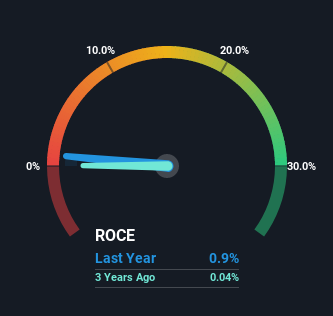- India
- /
- Personal Products
- /
- NSEI:JHS
JHS Svendgaard Laboratories (NSE:JHS) Will Want To Turn Around Its Return Trends
There are a few key trends to look for if we want to identify the next multi-bagger. Ideally, a business will show two trends; firstly a growing return on capital employed (ROCE) and secondly, an increasing amount of capital employed. Ultimately, this demonstrates that it's a business that is reinvesting profits at increasing rates of return. Although, when we looked at JHS Svendgaard Laboratories (NSE:JHS), it didn't seem to tick all of these boxes.
Understanding Return On Capital Employed (ROCE)
For those that aren't sure what ROCE is, it measures the amount of pre-tax profits a company can generate from the capital employed in its business. The formula for this calculation on JHS Svendgaard Laboratories is:
Return on Capital Employed = Earnings Before Interest and Tax (EBIT) ÷ (Total Assets - Current Liabilities)
0.0093 = ₹19m ÷ (₹2.3b - ₹260m) (Based on the trailing twelve months to December 2021).
So, JHS Svendgaard Laboratories has an ROCE of 0.9%. In absolute terms, that's a low return and it also under-performs the Personal Products industry average of 13%.
See our latest analysis for JHS Svendgaard Laboratories

While the past is not representative of the future, it can be helpful to know how a company has performed historically, which is why we have this chart above. If you're interested in investigating JHS Svendgaard Laboratories' past further, check out this free graph of past earnings, revenue and cash flow.
What The Trend Of ROCE Can Tell Us
When we looked at the ROCE trend at JHS Svendgaard Laboratories, we didn't gain much confidence. Around five years ago the returns on capital were 2.6%, but since then they've fallen to 0.9%. And considering revenue has dropped while employing more capital, we'd be cautious. This could mean that the business is losing its competitive advantage or market share, because while more money is being put into ventures, it's actually producing a lower return - "less bang for their buck" per se.
The Bottom Line On JHS Svendgaard Laboratories' ROCE
In summary, we're somewhat concerned by JHS Svendgaard Laboratories' diminishing returns on increasing amounts of capital. It should come as no surprise then that the stock has fallen 37% over the last five years, so it looks like investors are recognizing these changes. Unless there is a shift to a more positive trajectory in these metrics, we would look elsewhere.
If you want to continue researching JHS Svendgaard Laboratories, you might be interested to know about the 1 warning sign that our analysis has discovered.
While JHS Svendgaard Laboratories may not currently earn the highest returns, we've compiled a list of companies that currently earn more than 25% return on equity. Check out this free list here.
New: Manage All Your Stock Portfolios in One Place
We've created the ultimate portfolio companion for stock investors, and it's free.
• Connect an unlimited number of Portfolios and see your total in one currency
• Be alerted to new Warning Signs or Risks via email or mobile
• Track the Fair Value of your stocks
Have feedback on this article? Concerned about the content? Get in touch with us directly. Alternatively, email editorial-team (at) simplywallst.com.
This article by Simply Wall St is general in nature. We provide commentary based on historical data and analyst forecasts only using an unbiased methodology and our articles are not intended to be financial advice. It does not constitute a recommendation to buy or sell any stock, and does not take account of your objectives, or your financial situation. We aim to bring you long-term focused analysis driven by fundamental data. Note that our analysis may not factor in the latest price-sensitive company announcements or qualitative material. Simply Wall St has no position in any stocks mentioned.
About NSEI:JHS
JHS Svendgaard Laboratories
Manufactures, trades in, and sells a range of oral and dental products in India.
Excellent balance sheet with low risk.
Market Insights
Community Narratives




